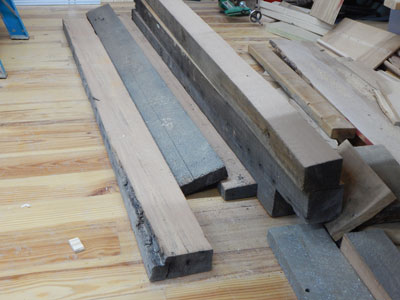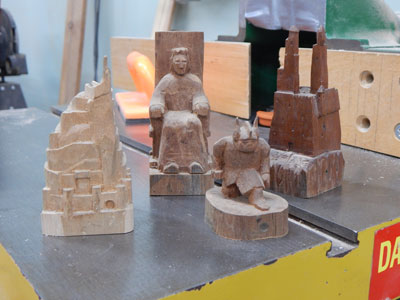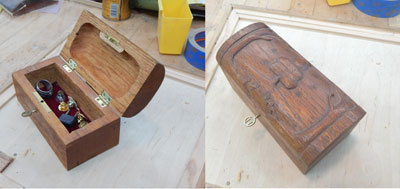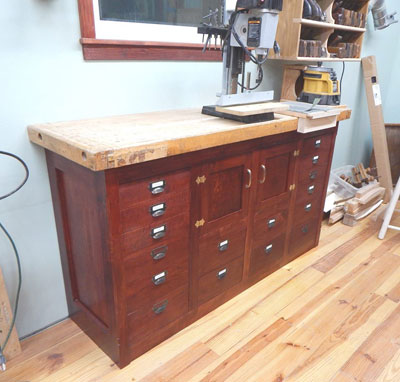|
It is February and I am working on a base cabinet for my woodshop. For two years the matching benchtop has been sitting on a folding table waiting for the cabinet. Seems like other projects keep coming along and taking a higher priority. In fact, as I look around my shop I also see: a Pennsylvania spice cabinet in progress, several jewelry boxes in pieces, some dimensioned lumber waiting to become a joiner's bench, some old tools sitting in pieces waiting to be restored, and a shop bathroom that doesn't yet have a door.

|
|
Figure 1 - Heart pine waiting to be a workbench
|
Projects started but not completed. Unfinished work hanging over my head. Should this bother me? Do I really have to finish every project that I start? Is this a character flaw or symptom of some deep-seated neurosis? Maybe I need a woodshop intervention or craftsman counseling.
"Unfinished Symphonies" are part of the catalog of great musical works. I suspect every classical composer worth his salt aspired to have one of these. Beethoven's 10th, Mahler's 10th, Bruckner's 9th. I always thought these were works-in-progress when the composer expired. It turns out that there are many reasons why something remains undone—some of them might make you feel better about that chair in the corner waiting to be refinished. Here are some:
-
Overly Ambitious Announcements
. Jean Sibelius (a famous Finnish composer) wrote seven major symphonic works and kept telling people that he was working on No. 8. Over the next 30 years of his life he never completed the symphony. There is some speculation that he wasn't satisfied with his product, however I think he took up icefishing and just told people he was working on a symphony. This is like me telling people that "I am working on a French classical desk a la David Roentgen based on a piece in the Metropolitan museum." I have actually told people this but please don't count it as an unfinished work if I never get around to it. In my mind I have started the thinking part of the project, maybe it will happen. Interesting sidenote: if you get to Finland and visit Ainola (Sebelius' home) you will see a beautiful green-tiled fireplace where he supposedly burned the 8th symphony in a fit of self-doubt and angst. Have you ever used one of your projects for firewood?

|
|
Figure 2 - Chess set in progress or tchotchkes?
|
-
Got in over my head
. Related to #1. Geoffrey Chaucer wrote the Canterbury Tales—a collection of at least 20 individual stories and poems. He was planning on writing 120 stories according to some. This could be why one of his characters offers the famous Arts and Crafts quote, "The Lyfe so Short, the Craft so Long to Lerne." In college I started carving a chess set along the Lord of the Rings theme. After blocking out 4 pieces (a king, a pawn, and two rooks) I did some serious reconsideration about the value of 28 more pieces. I now have four small carved objets d' art to sit on the shelf and I still play chess with a store-bought plastic set.
-
It Takes a While to Get it Just Right
. I just finished a project that I have been working on for 40 years. Back in high school I carved a jewelry box out of a solid block of wood. Again, inspired by the Lord of the Rings, I had a creative mental vision of a Dwarvish treasure chest. After wearing out several eXacto knives digging through two inches of white oak I decided it was done enough to be a box. No hinges, no lock, just a box with a loose lid that served well as a catchall on my dresser. This last year I looked at it and decided it really wasn't done after all and it still needed hinges and a lock. Now it is really done. Unless I decide to finish that carved banding around the lid … hmmm. If you have this kind of problem, consider Leonardo da Vinci. He painted the Mona Lisa over a 2-3 year period, then carted the painting around with him for another 15 years, adjusting, tuning, touching up. Now it hangs in the Louvre and is considered one of the greatest paintings of all time. Perfection takes time.

|
|
Figure 3 - 40 years to add hinges--perfection!
|
-
It's just not working for me
. Schubert's 8th is often titled his "Unfinished Symphony." He completed 2 out of 4 movements with some sketches of part of a third. He set the 8th aside and went on composing for another six years. Schubert was writing this one in a new style—the Romantic symphony. He was trying out new structures and sounds. One line of thought is that he didn't feel it coming together the way he wanted. A final observation on this one—some people think that parts of his efforts on the 8th ended up in some of his later works—incomplete parts finding a home in a future composition. I have a candlestick that my brother Ken created years ago when he was trying out spiral turning. He got the spiral part done but the candleholder part didn't work so well and it never got a base. It sits near the lathe waiting for the right opportunity to plug this piece into a new project.
-
It Really is Done, You Just Don't Get It
. Since the beginning of time there has been an argument about who is really an artist, which medium is superior to others. In the Renaissance this really came to a head in debates about painting vs. sculpture. Is a perfect statue of a human figure really a work of artistic expression or just a masterly copy of nature's own perfect design? Is the sculptor a craftsman or an artist? Deep stuff. One way out of this was for artists to get away from "naturalism" and explore more representative or figurative compositions. Donatello is credited with developing a form called "non finito" (Italian for "not finished") where he would sculpt part of the block of marble but not all. The "non finito" piece can convey the concept of the artistic process, or the soul of the material, or the theme of metamorphosis, or allow the viewer to engage the work in a personal way to imagine the completed piece. In woodworking we see this in projects that highlight live edges, bark, and unfinished surfaces. It really is done and you didn't have to sand and finish the whole thing!
-
The Lyfe so Short, the Craft so Long to Lerne
. Of course there are limits to our human existence and few of us will be able to wrap up all of our projects with a neat bow. Beethoven's 10th is a famous example where pieces of his final work were left behind on his death in 1827. Years later a Beethoven scholar pulled together the pieces and completed the 10th for its premier performance in 1988—160 years after Beethoven's passing. With many creative completions in literature, music, and art the second artist tries to understand the creative process of the original creator and complete the work in the same style. Grandpa B was working on a mahogany dining table and chairs near the end of his life. He got the table done enough for Grandma to use it for a party with clamps holding the sections together. The chair parts were all cut out, neatly tied together in sets with string. The parts stayed together in a box and have been passed along through the family. Eventually the parts ended up with a great-grandson who wants to try and complete the project.
In the field of Art there is an axiom, or principle, that "what the Mind can conceive the Hand should be able to execute." This principle applies to all creative activity such as music, painting, sculpture, writing, AND woodworking. Creative conception and actual execution are two very distinct skills and we all are gifted with them in different measures. Growing as a woodworker means developing both design abilities and manual skills to make the next project a little better, a little more refined, a little more beautiful. Unfinished works may be a part of the growing process, a recognition that perfect conception and execution are always just a little beyond our reach at the present time … but don't let that get in the way of making sawdust and having fun. Remember, "Done is better than perfect." Or is it?

|
|
Figure 4 - Finally got around to finishing that base cabinet I first mentioned
|
Bob Rummer works in Research at the University of Kansas and looks forward to getting into his woodshop full-time. He can be reached directly via email at
rummersohne@gmail.com
.
Return to
Wood News
front page
|





